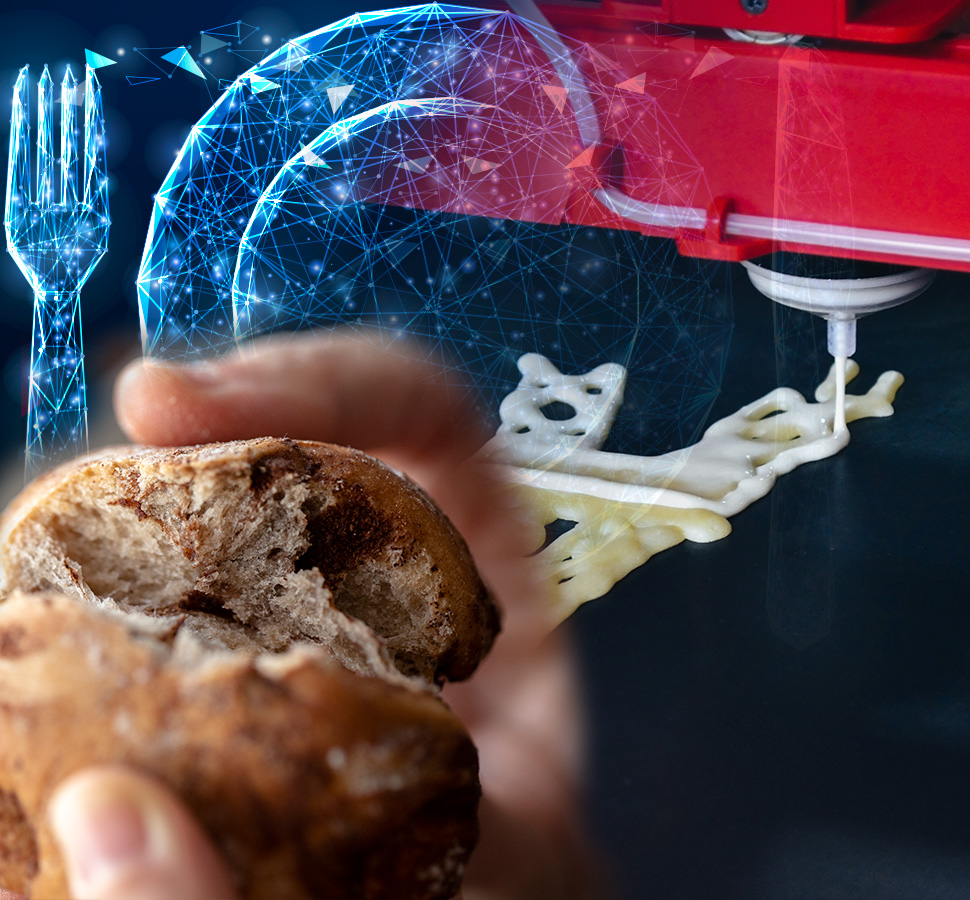8 Benefits to 3D-Printed Food
8 Benefits to 3D-Printed Food


From personalization to reducing waste, there are some real advantages to printing your next meal.
Designing and printing food with 3D printers is a new but rapidly advancing field. According to Quince Market Insights, the 3D-printed food market is forecast to expand at a compound annual growth rate of about 48 percent between now and 2030.
3D-printed food is made with standard 3D printers but using soft, edible materials that can be extruded through a nozzle. The printer follows a computer-generated model to deposit layers of material with extreme precision to create a final three-dimensional entrée. Food researchers must experiment with ingredient formulations and material properties such as viscosity to create the desired structure, flavor, and texture.
Below are eight advantages/benefits of 3D-printed food that are driving growth in the industry:
1. Customization
3D printing allows cooks and chefs to experiment with textures and designs that have never been created before. For example, engineers at Columbia University recently printed a seven-ingredient slice of cheesecake with an elaborate internal structure. Spectacular designs, complex colors and shapes, and even detailed logos can be achieved with 3D printing.
2. Personalized nutrition
Food “inks” can be formulated that provide the exact amount of vitamins, nutrients, and calories per meal for individual meals. These preparations can even include time-released ingredients. Personalized nutrition is important in healthcare settings for patients on restricted diets, or simply as a way to broaden meal offerings or meet food requests.3. Easier swallowing
People with dysphagia—a condition of difficult swallowing—often eat their meals after they have been processed in a blender, making the overall dining experience unsatisfactory. To remedy this, researchers from the University of Technology Sydney in Australia have 3D-printed pureed food into solid, 3D meals that are still safe to eat, visually appealing, and have pleasing texture.More on 3D printing: 3D Printing Steps into Housing
4. Plant-based “meat”
Several companies are 3D printing plant-based or vegetarian meat products that present the same texture, taste, and even smell of real meat. Considerable research chemistry is undertaken to formulate plant-based compounds that resemble and taste like meat, including blood (beet juice).5. Real meat
Scientists in Japan have3-D printed a cut of Wagyu beef that looks exactly like the real cut. A CAD model was used by the team to 3D-print the biomaterials that created the exact shape and composition of the steak—the result of building stacks of living cells to exactly replicate the complex structures of the muscle tissue, blood vessels, and fat.6. Reducing food waste
3D printing allows for using exactly the right amount of ingredients, so no material is wasted. In other situations, where there is wasted food, it can be recycled by being a material source for 3D-printed food. For example, Upprinting Food collects food that is destined for waste, mixes and prepares it, and then 3D-prints it into intricately designed, flavorful biscuits.7. Unconventional food consumption
Unconventional foods, such as unusual-looking but nutritious plants or protein-rich ingredients such as crickets, can be 3D-printed into more attractive food products with appealing textures and flavors—a good way to present them to the public and incentivize consumption.Editor's Choice: Using Robots to Deliver the Goods
8. Space travel
3D-printed food on manned space flights is getting serious attention from NASA for longer missions, such as travelling to Mars. This technology could be automated to produce nutritious and good-tasting meals in space. NASA has partnered with private-sector companies to develop the 3D printers and food inks for this purpose—including pizza.Bonus: Laser Cooking
Advances are coming quickly as 3D-printing firms expand the boundaries of 3D printing of foods. Now the ability to laser-cook of these foods has arrived. Researchers at Columbia University have designed a system that cooks 3D-printed food to a “mathematically precise finish” using infrared and blue light lasers. Their 3D printed and laser-cooked chicken samples had the same flavor profile and twice the moisture content as conventionally prepared and cooked chicken. A good sign they are on the right track is that “two blind taste testers preferred laser-cooked meat to the conventionally cooked samples, which shows the promise for this burgeoning technology,” said project leader James Blutinger.Mark Crawford is a technology writer based in Corrales, N.M.





